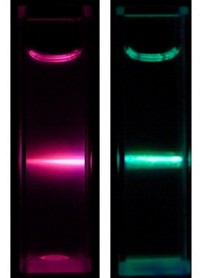Advertisement
Grab your lab coat. Let's get started
Welcome!
Welcome!
Create an account below to get 6 C&EN articles per month, receive newsletters and more - all free.
It seems this is your first time logging in online. Please enter the following information to continue.
As an ACS member you automatically get access to this site. All we need is few more details to create your reading experience.
Not you? Sign in with a different account.
Not you? Sign in with a different account.
ERROR 1
ERROR 1
ERROR 2
ERROR 2
ERROR 2
ERROR 2
ERROR 2
Password and Confirm password must match.
If you have an ACS member number, please enter it here so we can link this account to your membership. (optional)
ERROR 2
ACS values your privacy. By submitting your information, you are gaining access to C&EN and subscribing to our weekly newsletter. We use the information you provide to make your reading experience better, and we will never sell your data to third party members.
Analytical Chemistry
Luminescent Gold Nanoparticles Track Kidney Disease
Diagnostics: Following nanoparticles’ progress with fluorescence imaging can differentiate various stages of kidney failure
by Bethany Halford
February 8, 2016
| A version of this story appeared in
Volume 94, Issue 6
Kidney disease is known as a silent killer. That’s because the markers physicians look for to diagnose the disease, such as urea and creatinine levels in the blood, often appear normal even when up to 75% of kidney function has been lost. One inexpensive, noninvasive method for imaging kidneys is to use near-infrared fluorescence imaging to follow an organic dye as it travels through the organs. But such dyes have problems: They often don’t provide enough contrast in the kidney, and they accumulate in background tissues. Researchers led by Jie Zheng of the University of Texas, Dallas, previously reported that glutathione-coated gold nanoparticles work better than the dyes as fluorescence imaging agents for cancer detection. The nanoparticles, Zheng notes, are inexpensive and clear the body easily. Now Zheng’s lab has shown that the nanoparticles can differentiate between various stages of kidney dysfunction in a mouse model (Angew. Chem. Int. Ed. 2016, DOI: 10.1002/anie.201511148). If the results translate to people, doctors would be able to easily tell the difference among kidneys with normal function, mild dysfunction, and severe dysfunction—something they’re currently unable to do.




Join the conversation
Contact the reporter
Submit a Letter to the Editor for publication
Engage with us on Twitter